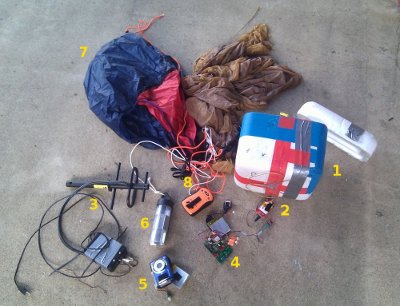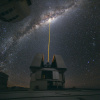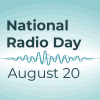We've talked in the past about high altitude balloon launches done by SparkFun employees (namely Nate's launch documented here, here, and here). Today, we're going to talk about SparkFun Engineer Aaron's launch. This was his first try at a high altitude balloon launch, so it's a great place to start if you're thinking of doing your first HAB project.
These are the items he put in his payload - the numbers correspond to the picture above:
- A foam cooler for the payload box.
- Next is the radio tracking system. Notice the wheel antenna mounted to the bottom of the box. Aaron used an omni-directional wheel antenna with a good amount of gain in the vertical direction, pointing down, and a 1 Watt Xbee as the transmitting radio.
- A Yagi antenna to receive the signals from the transmitter.
- The flight computer (green board) consisted of a custom designed PCB from BatchPCB, an ATmega328 powered at 3.3V, an ADXL345 accelerometer (for orientation), an HMC5843 magnetometer (for heading), a BMP085 temperature and pressure sensor (for elevation), a Copernicus GPS module (for position and backup elevation), an OpenLog (to record anything Aaron didn't get on his radio), and a tri-color status LED. The computer, as well as the radio and camera, were all powered separately with single cell 2000mAh LiPo batteries.
- The blue camera at the very bottom of the picture had a LiPo battery hacked onto the power plug and the camera ran a CHDK intervalometer script, so it continually took pictures and video.
- The silver-ish cylinder in the middle of the picture is the radio reflector. The FAA requires you to use one, so that radar/airplanes can see your balloon.
- This is the recovery parachute.
- And most importantly, in the center of the picture is the SPOT locator. This device sends position messages (unfortunately not altitude data) to a dedicated webpage every 10 minutes.
He stuffed all that into the cooler and sent it on up. He got some pretty cool results and definitely learned a lot. If you want to try your own high altitude balloon launch, you can check out Aaron's detailed write-up here. Safe flying!












I was actually in Boulder at the end of June for a balloon launch as part of the student hands on training for a nanosatellite competition that's sponsored by the AFRL. We had two cameras in it and here's a video of our launch: http://www.youtube.com/watch?v=EjrHHYZ51WY&feature=plcp
we reached a little over 85,000 ft, which is a huge thanks to Sparkfun because we got our Arduino, SD Shield, GPS shield, and temperature sensors from here.
I’ve flown nearly 100 HAB missions, about half of those with the xTend radios, and have experienced none of the issues that have been described by the SF staff… they’re fantastic radio modules, and I’ve achieved >50 mile links while maintaining compliance with the FCC regs on EIRP (for 900 MHz, the max allowed is 36 dBm). There are a couple of things that can bite you, though.
For example, if your RF symbol rate is set to 115,200 bps, you lose 10 dBm of receiver sensitivity, which is a big deal. For extremely long range links, you definitely want to use the 9,600 bps symbol rate. Note that this is not the serial port data rate, which is set separately, but the rate at which the radio transfers information over the air. Another big deal is the choice of antenna on the payload. The wheel antenna is essentially isotropic, which means that you’d wind up with 0 dBi of gain, which doesn’t make sense for a balloon payload. For essentially all of the flight, you’re going to be looking up at the balloon, which means that any power radiated up into space is wasted. A groundplane installed on your payload behind your wheel antenna should give you 2-3 dBi of additional gain, and a good patch antenna with approx 65 degree 3db beamwidth horizontal and vertical usually provides 6-9 dBi of gain (be careful with the EIRP limits, though – 1000 mW is 30 dBm).
Along with the antenna, the polarization relationship of the tx/rx antennas makes a big difference, as well. For example, the horizontal polarization of the wheel antenna is only evident when you’re looking at the antenna “edge-on;” otherwise, you’re essentially dealing with a circularly polarized antenna. The 6 dB yagi that you have in the picture is a linearly polarized antenna, which, when paired with a circularly polarized antenna, gives you 3 dBi of loss immediately.
I enjoy using a link margin calculator from AFAR communications (here: http://www.afar.net/rf-link-budget-calculator/). If you select distance mode, the results are telling. I typically aim for about 15-20 dB of fade margin when using the xTends (a generous noise floor). At a center freq. of 915 MHz, and setting the fade margin to 15 dB, the difference between the 115k and 9.6k theoretical distance (using 30 dBm Tx pwr, 0 dB of Tx cable loss and antenna gain, 6dBi rx antenna gain, 3 dBi rx cable loss (polarization), and the rx sensitivity from the datasheet) was 12.8 miles @ 115k RF symbol rate and 40.5 miles @ 9.6k RF symbol rate. When you remove the polarization loss, put a 6dBi antenna on the balloon side, use the 9.6k rate with a 20 dB fade margin, the theoretical distance is 64.1 miles, which is in keeping with my experience with the xTend’s performance.
I'm planning my second launch up in the next few weeks and I'd appreciate your help on antennas. From what i read above you recommend a patch antenna with a groundplane behind it for around 9 dbi of gain ideally, and use a low symbol rate of 9600 buad, yes? I plan for just broadcast communication using a 900mhz module to a ground station, somewhere around 1-5mw of power. What would you recommend for the ground station antenna? Also if the connection is good, i might try some two way communication as well. What would you recommend in that case? Sorry to badger you with so many questions, this stuff is hard to find answers for. Thanks!
Cool! Good luck on your upcoming flight.
Ultimately, the goal should be to achieve a fade margin that’s higher than your noise floor for a given transmission distance. Fade margin is essentially what’s left over when you add up your transmit power, all of your gains (antennas, amplifiers, etc), losses (cables, connectors, free space path loss), and receiver sensitivity. Thanks to the beauty of using log-based units, link budget calculations really are just adding and subtracting!
I guess I’m going to assume that you’re using xTend modules, though you can feel free to correct me if that assumption is off base. Essentially, I just need to know what the Rx sensitivity is for your ground station, and the xTend’s -110dBm is a good place to start. If we assume that you’re transmitting 5mW (really low, BTW), which is about 7dBm, and put a 9dBi antenna on the payload, for a fade margin of 15 dBm at a distance of 50 miles (near the minimum that I’ve seen for solid performance, but I’m near to a fair bit of 900 MHz SCADA systems in my area) you’d need a ~20 dBi receive antenna, but this will provide challenges in that the beam width (essentially how wide the gain pattern is) will be narrow, meaning that you’d need to be fairly accurate with your antenna pointing out at the maximum distance. As mentioned earlier, circularly polarized antennas can help with spin-tolerance, which may be a good thing with low signal levels, but, without a SWR meter (at least – a vector network analyzer is better), it can be difficult to build and properly tune hand-made skew-planar and helical antennas.
I’m curious about why you’ve elected to run such a low transmit power… increasing it is very easy way to increase SNR, and the power requirements for broadcasting 1W out of an xTend are easily handled by a good 3-cell 2200mAH lipo.
Anyway, I hope that this helps… if I can be of further assistance, feel free to let me know. I’ll keep an eye here for a few more days. Good luck!
Thanks! The transmit power is low because the 900mhz modules were donated to me and I'm testing the range for him, and since the Radiometrix 10mw modules can go over 100 miles (i've heard) I thought this may be possible. They are EasyRadio 900mhz transcievers with -110dBm of receiver sensitivity. My primary tracking means is a SPOT II I've good success with, so this is more of an experiment. So with this scant setup, I'd be looking at a strong helical for the ground reciever, and a 9dbi patch on the payload? Thanks for all your help!
All right - numbers are good! For a 10dBm (10mW) Tx with a 9dBi Tx antenna and just a touch of cable loss for good measure, I'm coming up with approx. 20dBi of Rx gain required for a comfortable fade margin at 50 miles out (just the baseline distance that I use), which is going to be a huge helical antenna with a pretty narrow beam. Difficult, but not impossible... here's another online calculator, this one for helical antennas: http://www.daycounter.com/Calculators/Helical-Antenna-Design-Calculator.phtml On your blog, you mention that the easyradio units are 433Mhz... all of the calculations that I've done so far are for 900MHz, which has substantially higher free space path loss. I just mention it becaus it's a fairly substantial difference (50 miles = approx. 130dBm loss @ 900MHz, 123dBm loss @ 433)... let me know. Also, FWIW, it may be possible to line up some additional equipment donations for you... I sent some contact info to the email address on your blog. Good luck!
I think it will be easier to correspond via email, thanks for taking the time and effort to help me out!
I've flown around 400 HAB missions. My first flight 25 years ago (8/15/1987) was the first HAB flight in the US back carrying film and video cameras with live TV transmissions. I've had great success with the 9XTend radios set for 1 watt. And as DaveP states, going with 9600 bps instead of the 115,200 bps will greatly increase your range. The link you show for the 1 watt XBEE shows a 50 milliwatt XBEE unit on 915 MHz. The range for that will be around 20 miles or less and not enough range for a typical high altitude balloon flight. However, I have had some success using the 100 milliwatt XBee Pro XSC unit (http://www.sparkfun.com/products/9087) from over 20 miles or more directly from a high altitude balloon to another XBee unit on the ground using a high gain yagi on the ground. The Copernicus GPS module that you used will work very well for high altitude ballooning, however you have to program the module for "AIR" mode otherwise it will fail above 27,000 feet. Once programmed for AIR mode it should work up to 162,000 feet. Another factor that will help prevent GPS failure is to keep digital cameras well away from the GPS antenna, the EMI created by the digital camera will desense the GPS unit enough to keep it from working. - Bill Brown WB8ELK http://www.wb8elk.com
I looked at the X-Tend modules when I started planning for my first launch, but decided to go with Radiometrix HX1-144.390-3 transmitter. It uses the national APRS frequency which has defined formats for reporting location. It worked great and I've seen a lot more people use the ham frequencies with success (Trackuino is one example). I'm launching another balloon later this month. Check out my website (sorry if this is considered spam) www.straybytes.com. I'll post how to follow the launch on APRS.fi as the date gets closer.
I am not sure it's a good idea to follow his tutorial given the fact his system failed above 9km. This is pretty usual in HAB actually (did 6 myself, including a livestream webcam launch). You could say that the temperature-to-airdensity is there at its minimum, which means it extracts a whole lot of heat from the payload. Also I see him using a 1Watt Digi X-Tend, i am unsure if that radio(power) is legal when you do not have a licence + radio is unattended (=sattelite). The DigiXtend is also known for its instability when it comes to HAB, it's range is supposed to be great but it's not always. You're better off using a Radiometrix ntx2. Ask the guys at "UKHAS" (united kingdom high altitude society) about it if you're interested, they have a very active mIRC channel.
Great call on talking to the UKHAS folks, they're rad. Catch me in their IRC channel under my username - come say hi!
I am not an engineer so take this with a grain of salt, but I agree with you cautioning against the X-Tend. As far as I know, the digi radios always require a two-way link to transmit data. The great thing about the NTX2 is that it's purely broadcast, so you only need to be able to pick up the signal and decode it. Even though it's just 10mW, I've received strong, readable signals from nearly 180 miles away when the payload is at altitude; it's truly a remarkable little unit.
That said, I'm glad people are trying different things! I'm looking to do another launch soon, maybe go for the 1500g altitude record ;)
I think Aaron himself would admit that his tutorial shouldn't be followed exactly, but it's a good place to start and learn where he succeeded and where he didn't. At the end of his tutorial he has a "things I learned" section that explains more about what he would do differently the second time around.
Yes, please don't follow my tutorial exactly, because you will get similar results. But please learn from my successes and failures. :)
Also, what I found when I was preparing for my first launch is that I couldn't read enough about previous HAB launches. It seemed every article I read, I learned something that helped me prepare.
Re. X-Tends: Good points. The X-tends are super simple to set up, just like any XBee, that is why I choose them. I didn't really expect to track the balloon the entire time, but I thought I could track it within about 10 miles (which is what I was getting with my ground testing). I am sure there are many better alternatives and I don't have a HAM license.
Re. license for the Xtends, FWIW, there are many others out there using these for HAB launches (without licenses), so I will plead ignorance on this one.
EDIT: Re. Digi two way: XTends do have a TX only feature that, I think, allows more power for transmitting.
IIRC the Amateur "900mhz" band overlaps the 900mhz ISM band so if you have at least a Technician ham ticket you would be good to go with the 1w XBee. If fact, if you have the ham ticket you could get a power amplifier boast the output a bit, I think the power limit on the ham band is 50w (depending on location) IIRC. I have an Extra Class ham ticket, but I've never played with anything above 2 meters (except for 450mhz FM repeater operation). The Technician ticket is not too hard to get (now that the code requirement is gone) and it opens the door for lots of interesting things including RC operations on 6 or 10 meters (limited availability of over the counter RC equipment or build your own), and lots of cool stuff on the higher frequencies.
I would be interested to know for sure if the 900MHz XTends need a license, I thought you didn't. Everything on Digi's website points to no. Where are you all referencing this information?
EDIT: I don't think a license is needed, if I am reading FCC part 15C correctly.
Hi! This is Jordan. I work for Digi as a Product Manager. You don't need a license to operate the XBee in the United States. The Digi 9XTend radio transmits in the 900MHz ISM band and transmits at the maximum allowed power output rating.
See also: http://www.afar.net/tutorials/fcc-rules/
Good luck on your next flight!
You linked to the device's approval. Consider, as an example, that a handheld Ham transmitter will be an FCC approved device -- but you need a license to operate it legally.
On a related note, how does Sparkfun sell all of these electronic devices without FCC IDs?
FCC 15C is an approval for a "radiator that can be operated without an individual license." Maybe there is something I am missing though.
Most of our products don't need to be certified, but the ones that do, we send them to FCC testing.
Very good, thanks for the info. I don't mean to pry, but I'm thinking of making and selling a PCB tuner. How much do you guys have to pay for your FCC device IDs? I have been reading about this, and I understand the way to do this is to hire a third-party lab which certifies the device. But I also read that usual costs for this service are $10k. OUCH.
I got an estimate recently from one testing company for FCC/CE testing for an intentional transmitter. Just the Bluetooth part of things will run about $10-$13k. The non-transmitting stuff runs another $15k or so.
Thanks, although it's even worse than I thought. :-/
Thanks for posting the very detailed list of materials. I have been visiting a lot of sites like yours, gaining "inspiration" for a similar project that I am kicking off with my daughter and some of her friends. We also plan to document the whole thing at http://hjerpefamily.net/Blogging/space2013/
for a second, that pic looks like a gory aftermath of a bike accident
Here was similar project in Lithuania in 2011 http://www.glory.lt/index.php .